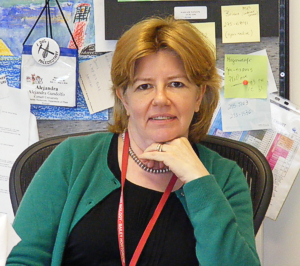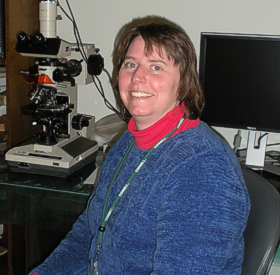
Dr. M. Alejandra Gandolfo
Principal Investigator
I was born and raised in Buenos Aires, Argentina. My family took long car trips all over the country and it was during those trips that I developed my interest for the outdoors and I learned of the freedom of working “outside an office”. I received my B.S. and M.Sc. degree in Ecology and Systematics from Universidad CAECE, a small private school. I had a fascinating Botany professor that woke up my interest in that discipline; for my M.Sc. I described a fossil angiosperm from the Laguna del Hunco paleoflora, Chubut, Patagonia.
Before completing my master thesis, I did field work in the Salamanca Formation, Patagonia and that was it, I was completely captivated with the possibility of spending time collecting fossils and be in the outdoors for extensive periods of time. I finished my PhD in Biology at the Universidad de Buenos Aires with two major components, Paleobotany and Geology.
For my Ph.D. thesis, I worked with the fossil and extant species of the genus Nothofagus. I did post-doctoral work at Cornell University with Drs. William Crepet and Kevin Nixon. We work on describing charcoalified fossil flowers from one of the most diverse Turonian (around 98 Ma old) floras found today.
My CV
Organizations I'm active in:
Plantsystemstics.org, Cladistics, American Philosophical Society, Fulbright, National Science Foundation, Botanical Society of America, Asociación Paleontológica Argentina, Museum Paleontológico Edigio Feruglio, Geological Society of America, Palaeontological Society, American Society of Plant Taxonomists.

Dr. Elizabeth Hermsen
Visiting Scientist
I was born in Green Bay, Wisconsin. I developed an interest in dinosaurs at a young age, and, when my family moved to Aurora, Colorado, I loved to visit the Denver Museum of Natural History. When I was between the ages of 11 and 14, we lived in a coal-mining town called Trinidad, Colorado, where I could hunt for fossils near my house. I finished high school in northern Wisconsin, where I volunteered with the US Forest Service’s archeologists and participated in field surveys and excavations in northern Wisconsin and South Dakota. I began studying botany and geology at the University of Wisconsin in 1995 with the intention of becoming a paleontologist. I volunteered as a vertebrate preparator at the university’s Geology Museum. I also did some field work collecting and excavating vertebrate fossils in Montana and Kansas and looking for fossil plants with Dr. Kirk R. Johnson, one of my current collaborators on the Patagonian paleofloras project, in North Dakota. I did my first research on fossil plants with Dr. Steven R. Manchester of the University of Florida in 1998. (This work was eventually published in the American Journal of Botany in 2000.) I completed a bachelor’s degree in 1999 and went to graduate school at Cornell University, where I received my Ph.D. in 2005. My dissertation was on the fossil history of saxifrages in North America, with particular emphasis on Itea (the Virginia willow) and Ribes (the currants and gooseberries). Since that time, I have worked on fossils from the Southern Hemisphere. From 2005 to 2008, I studied Triassic plants of Antarctica at the University of Kansas with Dr. Thomas N. and Dr. Edith L. Taylor. Following my postdoc, I relocated to California, where I briefly worked for the Forest Service in 2009 conducting plant surveys around Lake Tahoe. I returned to Cornell in 2009 to join the Patagonian paleofloras project.

Jennifer Svitko
Lab Technician
I was born and grew up in southwestern Pennsylvania. This area is known for its incredible Carboniferous beds rich in plant fossil remains. So, it is quite usual to find fossil while taking a stroll through the woods near old mines. While I had always been interested in general geology, these chance encounters with fossils sparked my interest in paleontology. Eventually, I went to California University of Pennsylvania majoring in geology, there I received my BS degree in 1990. That same year, I went on to get my M.S. with concentration in micropaleontology at Bowling Green State University. Finally, I defended my work on Pennsylvanian Age ostracodes of the family Bairdiidae in 1992. While working on my thesis, I did a lot of work at the university Scanning Electron Microscopy (SEM) center for photographing my ostracodes. At that time I did not know that this training will be fundamental for finding a job. I moved to Ithaca and I applied for a job working with Dr. William Crepet in 1993. A large portion of the position was SEM imaging of the charcoalified Turonian fossils flowers he and his colleagues were working on. My other duties in the lab included preparing, sorting, imaging, data basing the fossils, safety training for new lab members, and assistance to visitors to the lab. I was also responsible for the laboratory web page. For a while I worked at the Cornell Scanning Electron Microcopy Center where I did SEM and TEM (Transmission Electron Microscopy); when the facility closed I luckily got a new job working on molecular biology at the Bailey Hortorium with Dr. Jerry Davis. In 2010 I began working for Dr. Gandolfo on the Plant Ontology project. Although I have several responsibilities, the most important one is the imaging of the Cornell University Plant Anatomy Collection. I am in charge of training new workers, webpage development; and also contribute to basic but fundamental tasks to the project, such as literature searches and developing techniques for anatomical/morphological work.Grad Students

Caroline Siegert
Caroline is a first year PhD student studying fossil Malvaceae from the Laguna del Hunco site in Patagonia. She received her undergraduate degree in environmental and plant biology from Ohio University where she worked with Dr. Hermsen to describe a new species of angiosperms from the gray fossil site in Tennessee. Outside of the lab she raises carnivorous plants and has a personal fossil collection.
Undergrad Students
Previous Members
- Ryan Thummel
- Cesar Galan
- Teddy Matel
- Zackary “Zack” Kozma
- Rachel Peverly
- Nathan Jud- Post Doc, Patagonian Paleofloras
- Jessica Dobler- Quercus leaf trichome study
- Peter Meyer- Mesozoic leaf cutical
- Colton Poore- fossil Icacinaceae
- Chau Nguyen- CUPAC
- Ashlyn Lighbbown- CUPAC
- Elva Lau- CUPAC
- Emma Renner- CUPAC
- Marantha Dawkins
- Mary Futey- fossil Arecaceae
- Hanna Kim
- Sheik Shuvo
- Kimberly Wiman
- Ellen Wood